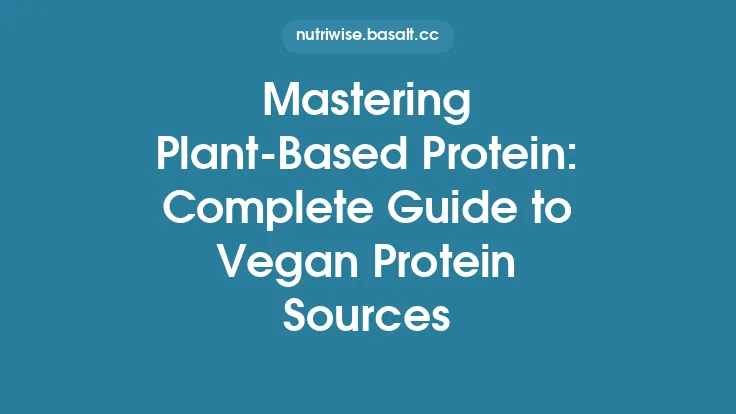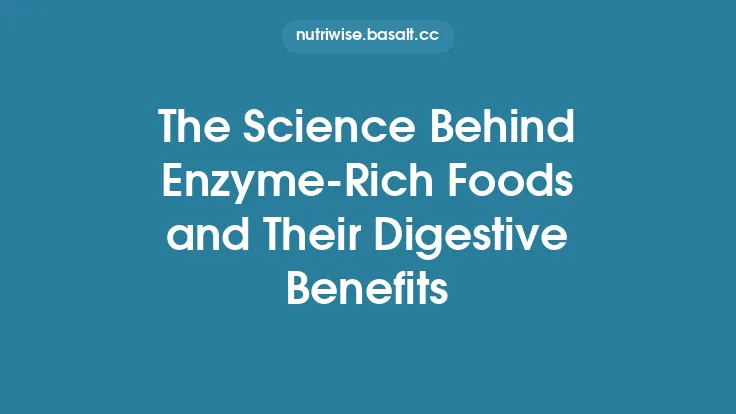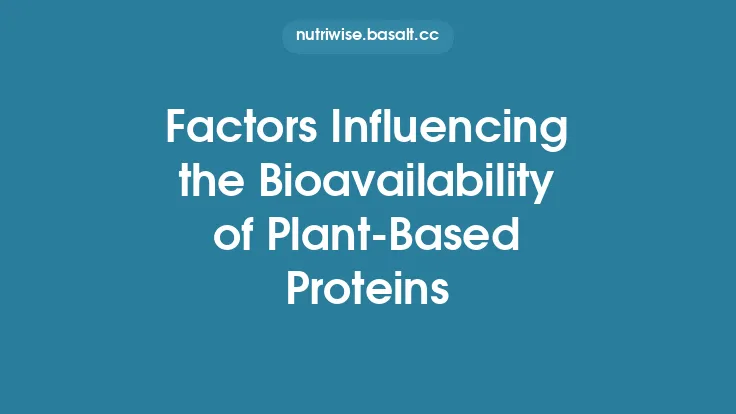Human digestion relies on a sophisticated cocktail of enzymes that are secreted by the salivary glands, stomach, pancreas, and intestinal lining. These enzymes work in concert to break down the macronutrients we consume—carbohydrates, proteins, and fats—into absorbable units. Over the centuries, humans have also turned to the plant kingdom for enzymatic assistance, whether through traditional culinary practices (e.g., using pineapple to tenderize meat) or modern food‑technology applications. Understanding how the enzymes produced by our own bodies compare to those harvested from plants is essential for food scientists, nutritionists, and anyone interested in optimizing nutrient availability without compromising safety or efficacy.
Overview of Human Digestive Enzyme Systems
The human digestive tract produces a relatively limited set of enzymes, each highly specialized for a particular substrate and physiological niche:
| Enzyme Source | Primary Enzymes | Typical Substrate | Approx. Secretion Rate* |
|---|---|---|---|
| Salivary glands | α‑amylase, lingual lipase | Starch, triglycerides | 0.5–1 g/day |
| Stomach | Pepsin, gastric lipase | Proteins, fats | 0.2–0.4 g/day |
| Pancreas | Pancreatic amylase, trypsin, chymotrypsin, elastase, pancreatic lipase, colipase | Carbohydrates, proteins, fats | 2–3 g/day |
| Small‑intestinal brush border | Maltase, sucrase, lactase, peptidases | Disaccharides, oligo‑peptides | 0.1–0.3 g/day |
\*Values are approximate averages for a healthy adult consuming a mixed diet.
Key characteristics of human enzymes include:
- Isozyme diversity – Multiple isoforms of the same catalytic activity (e.g., several pancreatic amylases) provide redundancy and fine‑tuned regulation.
- Tight regulation – Enzyme secretion is controlled by hormonal (e.g., secretin, cholecystokinin) and neural signals, ensuring that activity matches the incoming nutrient load.
- High substrate specificity – Human enzymes have evolved to recognize the exact glycosidic linkages, peptide bonds, or ester bonds present in typical dietary components.
Plant‑Based Enzyme Sources: Diversity and Availability
Plants synthesize a broad spectrum of hydrolytic enzymes for their own metabolic needs, defense mechanisms, and seed germination. When harvested for human use, these enzymes are typically obtained from:
| Plant Source | Predominant Enzyme(s) | Typical Extraction Method | Commercial Applications |
|---|---|---|---|
| Pineapple (Ananas comosus) | Bromelain (cysteine protease) | Aqueous extraction, precipitation, chromatography | Meat tenderizers, anti‑inflammatory supplements |
| Papaya (Carica papaya) | Papain (cysteine protease) | Similar to bromelain | Protein‑based dietary aids, bakery dough conditioners |
| Kiwi (Actinidia deliciosa) | Actinidin (cysteine protease) | Cold‑water extraction, ultrafiltration | Dairy product softening, functional beverages |
| Fungi (e.g., Aspergillus niger) – technically not a plant but often grouped in “plant‑derived” enzyme preparations | α‑amylase, cellulase, pectinase | Solid‑state fermentation, downstream purification | Baking, juice clarification, dietary supplements |
| Sprouted grains (e.g., barley, wheat) | α‑amylase, β‑glucanase | Germination followed by drying and milling | Bread improvers, malted beverages |
Plant enzymes are generally harvested from the fruit, seed, or vegetative tissue where they are most abundant. The extraction process aims to preserve catalytic activity while removing pigments, phenolics, and other matrix components that could interfere with downstream use.
Structural and Functional Similarities
Despite originating from vastly different kingdoms, many plant enzymes share a common catalytic architecture with their human counterparts:
- Catalytic Triad/Diad Conservation – Cysteine proteases such as bromelain and papain possess a Cys‑His‑Asn catalytic triad that mirrors the active site geometry of human cathepsins (lysosomal proteases). This structural congruence underlies their ability to hydrolyze peptide bonds in a comparable manner.
- Glycoside Hydrolase Families – Plant α‑amylases belong to GH13, the same glycoside hydrolase family that includes human pancreatic amylase. Sequence alignment reveals >50 % identity in the catalytic domain, explaining why plant amylases can effectively cleave α‑1,4‑glycosidic bonds in starch.
- Metal‑Dependent Catalysis – Certain plant cellulases and pectinases require divalent metal ions (e.g., Ca²⁺) for structural stability, a feature also observed in human pancreatic lipase, which relies on a calcium‑binding loop for proper folding.
These shared motifs mean that, at the molecular level, plant enzymes can often substitute for human enzymes in vitro, provided that the surrounding environment (pH, ionic strength) is compatible.
Differences in Optimal Operating Conditions
While structural homology exists, the physiological context in which each enzyme evolved leads to distinct performance envelopes:
| Parameter | Human Enzyme | Plant‑Derived Enzyme |
|---|---|---|
| pH Optimum | Stomach: ~2 (pepsin); Pancreas: ~7.5–8 (amylase, lipase) | Bromelain: 5.5–8; Papain: 6–7; Plant amylases: 5–6 |
| Temperature Optimum | 37 °C (body temperature) | 45–55 °C for many fruit proteases; some fungal amylases peak at 60 °C |
| Stability to Proteolysis | Highly resistant to self‑digestion (zymogen activation) | Susceptible to gastric proteases; may be partially degraded before reaching the small intestine |
| Glycosylation Patterns | Complex N‑linked glycans that protect against denaturation | Often O‑glycosylated or lightly N‑glycosylated, influencing solubility and immune recognition |
These differences have practical consequences. For instance, a plant protease that is most active at neutral pH may retain activity in the small intestine but could be inactivated in the acidic stomach unless protected by an enteric coating. Conversely, the higher temperature optimum of many plant enzymes can be advantageous during food processing (e.g., baking) where the dough temperature exceeds 40 °C.
Bioavailability and Activity Retention Through the Gastrointestinal Tract
The journey from ingestion to the site of action determines how much of a plant enzyme remains functional:
- Gastric Transit – The acidic environment of the stomach can denature enzymes lacking acid stability. Some plant proteases (e.g., bromelain) exhibit partial resistance, but a significant fraction may be hydrolyzed by pepsin. Formulation strategies such as microencapsulation or pH‑responsive polymers are employed to shield the enzyme until it reaches the duodenum.
- Pancreatic Enzyme Competition – Once in the small intestine, endogenous pancreatic enzymes dominate the proteolytic landscape. Plant enzymes must either act synergistically (e.g., providing additional proteolytic capacity) or compete for substrate. Studies have shown that bromelain can complement pancreatic proteases by cleaving peptide bonds that are sterically hindered for human enzymes.
- Mucosal Absorption – Some plant enzymes, particularly low‑molecular‑weight proteases, can be partially absorbed intact across the intestinal epithelium. This phenomenon is the basis for the systemic anti‑inflammatory effects reported for bromelain, though the exact mechanisms remain under investigation.
Overall, the net bioavailability of plant enzymes is lower than that of endogenous enzymes, but the functional contribution can still be meaningful, especially in individuals with compromised pancreatic output.
Clinical and Nutritional Implications of Substituting Plant Enzymes
When human digestive capacity is insufficient—due to pancreatic insufficiency, aging, or certain gastrointestinal disorders—plant‑derived enzymes can serve as adjuncts:
- Pancreatic Exocrine Insufficiency (PEI) – Patients with cystic fibrosis or chronic pancreatitis often receive pancreatic enzyme replacement therapy (PERT). Plant proteases such as papain have been explored as supplemental agents to improve protein digestion, particularly for meals that are high in collagen or gelatin, which are less efficiently hydrolyzed by human enzymes alone.
- Age‑Related Decline in Enzyme Secretion – Elderly individuals may experience reduced gastric acid and pancreatic output. Incorporating bromelain or papain into meals can modestly enhance protein breakdown, potentially improving nitrogen balance and muscle maintenance.
- Food Intolerances – Certain carbohydrate intolerances (e.g., lactose intolerance) are traditionally managed with lactase supplements. While plant lactases are less common, some fungal-derived β‑galactosidases (often grouped with plant enzyme preparations) can aid in carbohydrate digestion without invoking the same regulatory concerns as bacterial enzymes.
It is important to note that plant enzymes are not a wholesale replacement for human enzymes. Their activity spectrum is narrower, and they may lack the precise regulatory feedback mechanisms that prevent over‑digestion. Consequently, clinical use typically involves combination therapy rather than substitution.
Practical Considerations for Food Scientists and Product Developers
When integrating plant enzymes into food products or nutraceuticals, several technical factors must be addressed:
- Enzyme Activity Units – Human digestive enzymes are often expressed in International Units (IU) based on substrate turnover at physiological pH and temperature. Plant enzyme manufacturers may use different assay conditions (e.g., higher temperature). Converting between units requires careful calibration to ensure that the final product delivers the intended catalytic capacity.
- Stability During Processing – Heat‑processing steps such as pasteurization, baking, or extrusion can inactivate many plant enzymes. Selecting thermostable variants (e.g., fungal amylases) or applying post‑process enzyme addition can preserve functionality.
- Sensory Impact – Proteolytic activity can generate free amino acids and peptides that influence flavor. While this can be desirable (enhanced umami), excessive proteolysis may lead to bitterness. Formulation trials should balance enzymatic activity with sensory quality.
- Regulatory Landscape – In many jurisdictions, plant enzymes are classified as food additives or processing aids, each with distinct labeling requirements. Understanding the distinction is crucial for compliance, especially when marketing products that claim digestive benefits.
- Allergenicity – Some plant enzymes, particularly those derived from tropical fruits, have been associated with allergic reactions in sensitized individuals. Conducting allergen risk assessments and providing clear labeling mitigates consumer safety concerns.
Future Directions in Comparative Enzyme Research
The field is moving toward a more nuanced understanding of how plant enzymes can complement human digestion:
- Omics‑Driven Discovery – High‑throughput transcriptomics and proteomics of under‑explored plant species (e.g., exotic fruits, medicinal herbs) are revealing novel proteases and carbohydrases with unique substrate specificities that may fill gaps in human digestive capacity.
- Protein Engineering – Directed evolution and rational design are being applied to plant enzymes to shift their pH and temperature optima closer to human physiological conditions, improve resistance to gastric proteolysis, and reduce immunogenic epitopes.
- Microbiome Interactions – Emerging evidence suggests that plant enzymes can modulate gut microbial composition by altering the pool of undigested substrates. Understanding these indirect effects could open new avenues for functional food development.
- Personalized Nutrition – As genetic testing identifies individuals with specific enzyme deficiencies (e.g., low lactase activity), tailored supplementation with plant‑derived enzymes could become part of precision nutrition strategies.
In summary, while human digestive enzymes remain the primary drivers of nutrient breakdown, plant‑based enzyme sources offer valuable complementary tools. Their structural similarity enables functional overlap, yet differences in stability, optimal conditions, and bioavailability necessitate thoughtful integration. For food scientists, clinicians, and nutritionists, leveraging the strengths of both systems can enhance digestive efficiency, improve food quality, and support health across diverse populations.





